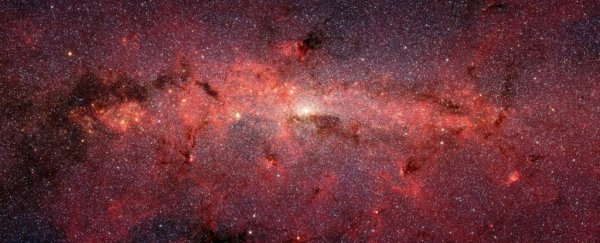There isn't just one black hole at the heart of the Milky Way. Scientists have found a dozen clustered around its supermassive core, Sagittarius A* - and their results imply that there might be up to 20,000 black holes crowding up the inner region of our galaxy.
The research is based on a decades-old theory that there should be a localised increase in the number of stellar-mass black holes in the vicinity of a supermassive one - this is also called a 'black hole density cusp'.
In fact, it's a fundamental part of our current model of galactic stellar dynamics.
But previous attempts to find evidence of these black holes around Sagittarius A* - the closest supermassive black hole, and therefore the most accessible to study - have yielded nothing.
"There are only about five dozen known black holes in the entire galaxy - 100,000 light years wide - and there are supposed to be 10,000 to 20,000 of these things in a region just six light years wide that no one has been able to find," said Chuck Hailey, an astrophysicist at Columbia University and lead author of the study.
"There hasn't been much credible evidence."
To find the black holes, the team had to think outside the box. Black holes are tricky to locate, since they themselves don't give off any radiation - in fact, they absorb all detectable radiation (theoretically they emit Hawking radiation, but we can't detect that).
But that doesn't mean they can't be found with other devices.
When a black hole "wakes up" and consumes matter, this creates detectable X-ray radiation. And the black holes that are the most active are those paired with a star in a binary system. As X-ray binaries, these black holes consume matter from the star, sometimes resulting in bright X-ray flashes.
Previous efforts to find more black holes at the centre of our galaxy has focused on these X-ray binary flashes. But there's a problem with that method.
"It's an obvious way to want to look for black holes," Hailey said. "But the galactic centre is so far away from Earth that those bursts are only strong and bright enough to see about once every 100 to 1,000 years."
So, instead of waiting for these strong bursts, the team took a different approach.
Sifting through data accumulated by the Chandra X-ray Observatory over the past 12 years, they looked for the fainter, but steadier, X-ray signature produced by inactive X-ray binaries, where the black hole is paired with a low-mass star.
"It would be so easy if black hole binaries routinely gave off big bursts like neutron star binaries do, but they don't, so we had to come up with another way to look for them," Hailey explained.
"When black holes mate with a low mass star, the marriage emits X-ray bursts that are weaker, but consistent and detectable.
"If we could find black holes that are coupled with low-mass stars and we know what fraction of black holes will mate with low-mass stars, we could scientifically infer the population of isolated black holes out there."
In the Chandra data, they found 12 of these signatures, all within 3 light-years of Sagittarius A*.
Then they analysed the properties and spatial distribution of these binaries, and extrapolated on these findings to conclude that there must be somewhere between 300 and 500 low-mass binaries in the Milky Way's central parsec, and around 10,000 lone black holes.
Boom. There's your black hole density cusp.
This supports the hypothesis that the massive halo of gas and dust around Sagittarius A* has produced many massive stars that have lived, died and collapsed into black holes.
It also supports the hypothesis that stellar-mass black holes have "fallen" towards the galactic centre from other parts of the galactic bulge.
"This finding confirms a major theory and the implications are many," Hailey said.
"It is going to significantly advance gravitational wave research because knowing the number of black holes in the center of a typical galaxy can help in better predicting how many gravitational wave events may be associated with them.
"All the information astrophysicists need is at the centre of the galaxy."
The team's research has been published in Nature.
